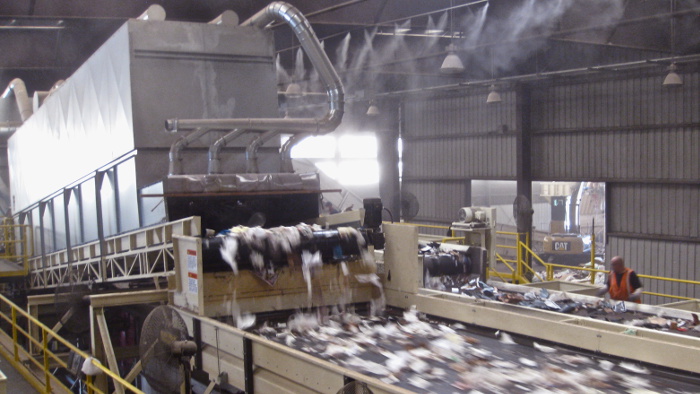Grand Central Recycling and Transfer placed into service a new Bollegraaf MRF that uses a single processing line to sort a variety of material streams.

Distributor VAN DYK Recycling Solutions utilized cutting-edge technology to allow the same line to switch between different waste streams. This innovative plant can process and sort residential single stream, dirty and dry commercial waste, and multi-family MSW all over a single processing line. “It is a scalable alternative for the recyclers who do not have the capital, volume, or needs for a multiple line Mega MRF,” states Wilfred Poiesz, Western Vice President of VAN DYK Recycling Solutions.
Grand Central CEO Dave Perez adds, “For a growing private hauling company like us, this unique multi-material system provides great opportunities. We now can process most waste streams that we currently collect on our trucks and become less dependent on the rising cost of landfill disposal fees.”
Grand Central’s goal in building this new MRF is to maximize diversion by designing a system that could replace the existing manual sorting operation, increase throughput, and act as an extension to GCR’s existing transfer station. The new plant uses additional automation to allow the processing of higher volumes of materials without increasing labor costs. In addition, the new MRF is designed to start digging deeper into Grand Central’s incoming waste streams and reduce disposal costs.
After a competitive RFP process, VAN DYK Recycling Solutions was selected as the vendor that responded with the most creative design, and who was flexible enough to handle multiple material types. Incorporating a nice balance between conventional low maintenance technology and a highly automated sorting system, the VAN DYK system is capable of effectively processing 600–700 tons per day of any type of incoming material all on the same processing line. “The fact that VAN DYK Recycling Solutions could think outside the box allowed them to formulate the most competitively priced proposal as well as the best use of space and people,” states Pete Perez, General Manager of Grand Central Recycling.
Grand Central’s MRF utilizes air based technology from Bollegraaf and Walair in addition to sensor based sorting technology from TOMRA. “The use and flexibility of sensor and air based sorting technologies allows Grand Central to immediately adjust and reset the line for different material streams. The air and optical sensor technology also limits maintenance and cleaning associated with traditional MRFs,” says Jeff Duhamel, Consultant at Waste Systems Technology, Inc.
He continues, “It was clear that conventional technology would be problematic for this material. Bollegraaf came up with a solution that works without extensive maintenance and cleaning requirements. Their advanced process enables GCR to significantly enhance the depth of diversion, raise recovery rates, and minimize O&M costs.”
Grand Central built the system to increase waste diversion as a direct response to the anticipated closure of the Puente Hills landfill in the fall of 2013. California’s laws have also changed and require higher diversion goals for commercial and residential customers. Grand Central’s new facility assures that their customers will meet these new recycling requirements.
Pete Perez adds, “Everybody can process clean recyclables. It is of great value to be able to dig deeper into our mixed commercial and MSW waste stream. Our new system enables us to reclaim considerable amounts of previously untouched recyclables, while the size reduction and mechanical separation components help to prepare and protect our sorting staff. TOMRA sensor based sorting technology enables us to adjust and monitor our output quality to meet the strict ‘Green Fence’ imposed quality standards.”
The new MRF initially sorts material by size and density into separate streams:
- Large items for manual sorting of wood, metals, cardboard, and film
- High density products such as glass, metals, e-waste, phonebooks, large organics, wood, and other inerts
- Medium density products such as containers, magazines, small wood, and fabrics
- Low density products such as paper and films
Each waste stream is then refined using TOMRA sensor based sorting and manual quality control to prepare clean materials for market.
Close cooperation between GCR operations and system integrator VAN DYK Recycling Solutions has resulted in various “recipes” for processing the different waste streams from different geographic areas or accounts. Currently, four separate sorting modes and many pre-programmed sensor based sorting tasks are used to process single stream, mixed commercial, multi-family MSW, and C&D.
GCR presently recovers a greater percentage of fiber, containers, wood, and metals than our previous sorting operations. Their new BOLLEGRAAF processing system helps afford GCR a recovery system that increases hourly throughput by 350 percent.
VAN DYK Recycling Solutions has recently completed large-scale MRFs for the state of Rhode Island and Canada Fibers in Toronto, as well as six new MRFs for Waste Management. VDRS is currently in the process of installing the largest MRF in the country for SIMS Recycling at the Brooklyn Navy Yard. The MRF will process all of New York City’s recyclables.
VAN DYK Recycling Solutions is headquartered in Stamford, CT and is North America’s largest systems integrator for the recycling industry. The company exclusively represents Bollegraaf, Lubo, Walair, and TOMRA.
